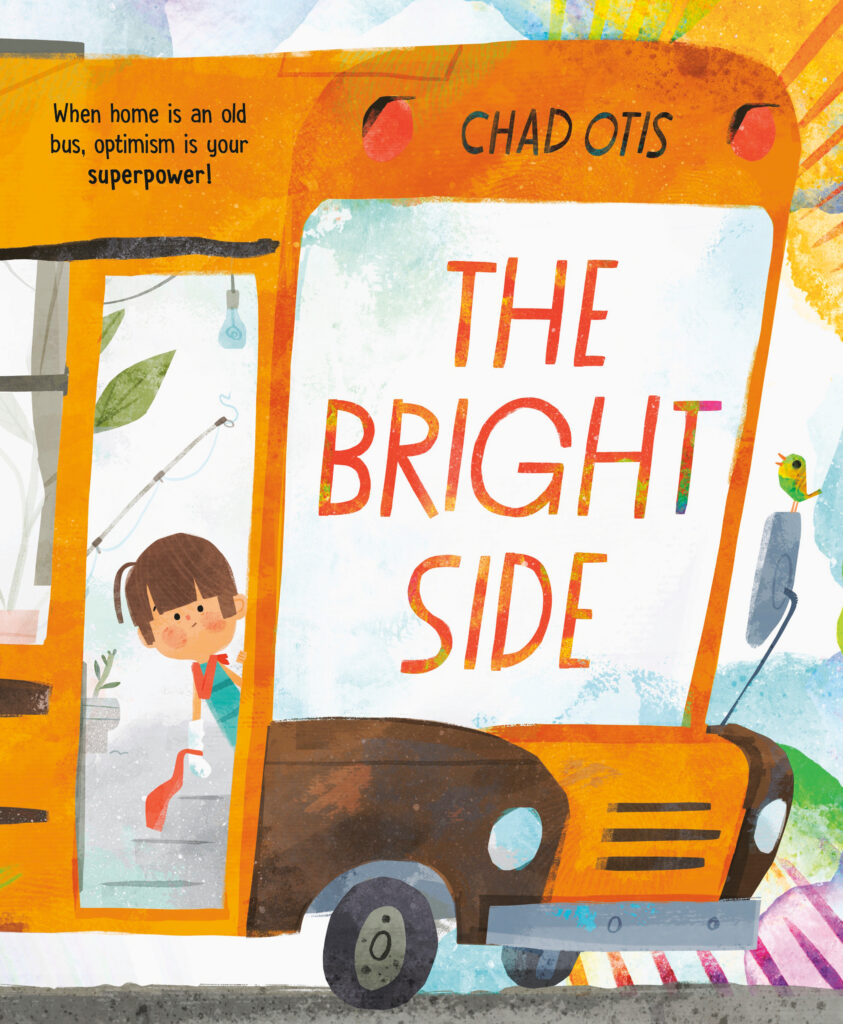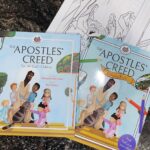Today I’m pleased to have Chad Otis here to talk about his new book, The Bright Side. The Bright Side is a non rhyming, brightly illustrated picture book telling the story of a creative little boy who’s family is dealing with housing insecurity.
This post may contain referral links for these products. As an Amazon Associate I earn from qualifying purchases. It does not cost you extra to purchase through my links.

Picky mom review of The Bright Side by Chad Otis
I really liked The Bright Side. It makes housing insecurity part of the main character’s experience, but not his defining feature. In some other books it comes across like, “This is a homeless character. That’s it. That’s all that’s interesting about them.”
Instead, The Bright Side‘s main message is about creative thinking, and problem solving, but on the background of houselessness.
It is written at a gentle, age appropriate level for even very young children. I would happily read this to any age, but think the sweet spot is around first and second grade because the main character’s dilemma takes place at school. However, there is not a ton of text on each page, so you could easily read it to younger kids. Highly recommend!
Interview With Chad Otis, author/illustrator of The Bright Side

Hi, Chad, thanks for answering my questions! I loved the theme of creative problem solving together in your story. What sort of creative problem solving did you have to do juggling both author AND illustrator of The Bright Side?
Crafting a story about housing and food insecurity for children, and from a child’s perspective, was daunting at first. Being the author and illustrator (in control of the “show” and the “tell”) allowed me to leverage both things and keep them uncommitted up until the very end. Especially with a story like this, the illustrations, and the words each need to do a lot of work.
For example, the first spread needed to kick off the story by intimating that the family was being forced into houselessness, and our hero being separated from his friends, without setting an overly dark tone for the book. My solution was to show a “FOR RENT” sign over what might be an eviction notice, the shabby-looking bus and its hastily stowed belongings being trailed by his friends, and his concerned-looking mother seated up front. Together with the words “…until we can get a normal house again.” I feel like it strikes that balance and does the job.
If you could give every grown up who reads your book to a child a 1 or 2 sentence script of what to say after reading, what would it be?
Even as of 2019, the number of houseless kids in public schools had “increased by about seventy percent over the past decade,” according to the Education Department. So, many kids who have this book read with their families might be experiencing some version of this story.
For these kids, I might say:
“You aren’t alone in this – there are other kids like you. Be proud of who you are now, and of who you will become. Try not to worry. If you keep imagining and trying, you will do amazing things. You will have the SUPERPOWER of looking on the bright side!”
For kids who aren’t experiencing housing and food insecurity, I might say:
“You are lucky to have so much. There are kids who don’t always know where they’re going to sleep at night, or what they’ll eat. Be kind to everyone no matter what their clothes look like, if they come to school in the middle of the year, or if they just don’t have as much as you. It’s not their fault. Be nice and treat them like everyone else. They just want to have friends, play, and learn just like you.”
Readers of my website are reading books aloud to all kinds of children, including those with housing or food insecurity. Do you have any tips or recommendations for grown ups reading to kids who are navigating these situations? For example, is it better to stay away from books that are too “life-like,” or is seeing your own experiences mirrored in characters beneficial?
It’s been said that stories can be windows or mirrors. I think the best ones are both.
I feel like it’s always best for kids to see themselves in a story. If the entire audience can relate to universal themes like the hope, love, and the need to belong, then the individuals will be more likely to empathize with each other. There have been a number of picture books that try to educate kids on houselessness from an adult perspective. While well-meaning, I don’t think they resonate with kids as well as a more relatable story. And they tend to show roles of “us” more explicitly and “them,” which unintentionally applies a level of shame to the “them.”
Having experienced these things as a child, I can tell you that feeling like an outsider, and feeling shame is the toughest part. Dealing with the anxiety of living on a bus, in a car, in a shelter, or being hungry and cold isn’t as tough as the things that happen in full view of your peers. I think the best way for adults to present the story is as a reminder to all of the kids that we don’t necessarily know what others are dealing with. It might also be a good opportunity to remind kids that it’s okay to share with an adult – later, outside of the group – if they need anything like food or warm clothes.
There’s an organization called Alice’s Kids that discreetly helps kids who can’t afford things like warm winter coats, shoes, backpacks, school supplies, glasses and even sports equipment. Because “poverty shaming” can be a problem – Alice’s Kids provides these things in a way that doesn’t draw attention to the kids who receive them.
I became aware of Alice’s Kids when they were mentioned by one of my favorite people, Patton Oswalt, on Celebrity Jeopardy!
You can learn more at aliceskids.org, or follow @alicewillhelp on Twitter and Instagram.
If readers enjoy this book, do you have any others you recommend?
If readers like the blend of engagement and message in The Bright Side, they might like my next book about a boy who “…might just be the neatest kid ever.” I can’t share the title quite yet but, it’s about a little guy who really, really doesn’t like messiness of any kind. Like lack of tidiness, weird smells, broken routines, loud and jumbled sounds. (He’s an “avoider” not a “seeker”). He has to decide what to do when love and messiness happen to come in the same surprise package!
It’s with the same publisher and editor as The Bright Side, Lauri Hornik at Rocky Pond Books.
Stay up to date on everything here: chadotis.com


